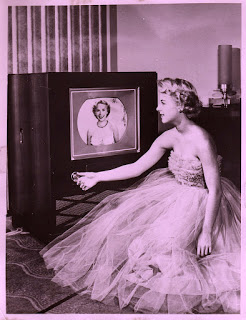 Found in the fascinating El Mundo photo archive is this shot of a ‘pretty girl tuning in a colorcast on a color video receiver ‘before the assembled American press on 17th December 1953. This was a prototype; commercial broadcasting in color began the following year. I don’t know when TV reached Argentina, let along colour TV, but British viewers were only offered colour in 1967, nearly 14 years after it had been unveiled in the States. Apparently, colour had been in development across the Atlantic from the earliest days of TV but due to technical and other problems, the service was delayed for many years.
Found in the fascinating El Mundo photo archive is this shot of a ‘pretty girl tuning in a colorcast on a color video receiver ‘before the assembled American press on 17th December 1953. This was a prototype; commercial broadcasting in color began the following year. I don’t know when TV reached Argentina, let along colour TV, but British viewers were only offered colour in 1967, nearly 14 years after it had been unveiled in the States. Apparently, colour had been in development across the Atlantic from the earliest days of TV but due to technical and other problems, the service was delayed for many years.My own family were initiated into the TV age in 1951—before the Coronation—when my mother was given a leaving present of a new sixty guinea Bush receiver by a grateful employer. But if someone had told us in 1954 that in America families were gathering around what appears to be a 16” screen (ours was a tiny 10 inch one) to watch programmes in colour, we would have thought it incredible.
Of course, the very earliest TV screens in the UK were even smaller—I mean the ones receiving programmes from c 1934 – 1939. I was obliged to do research on early broadcasts while working on a book about Geoffrey Grigson a few years ago. He, John Piper and John Betjeman were popular TV broadcasters (mainly on art) in the late thirties.
Incidentally, why has no-one published a social history of this early TV era in Britain ? It would be fascinating.
[R.M.H.]

